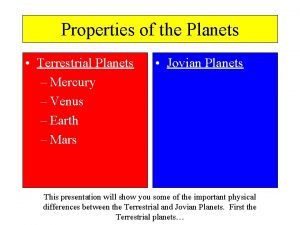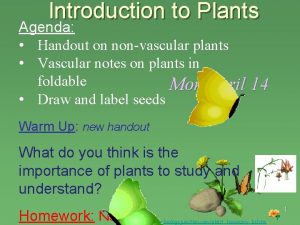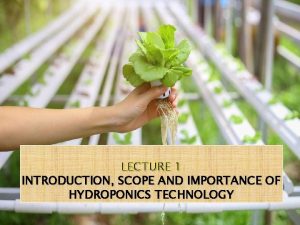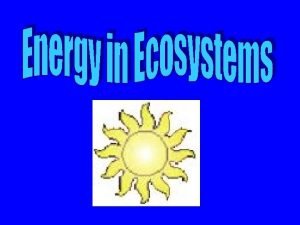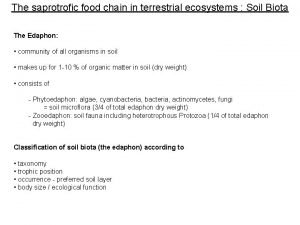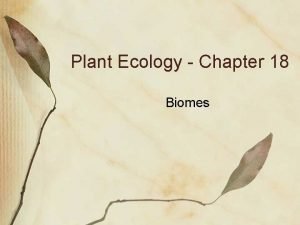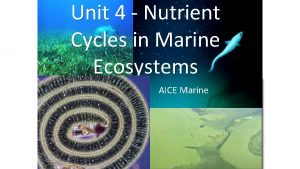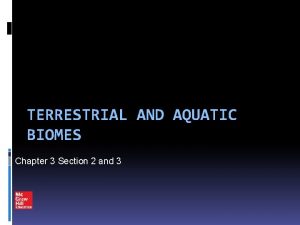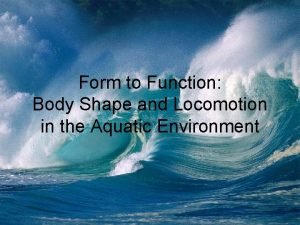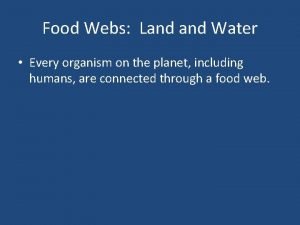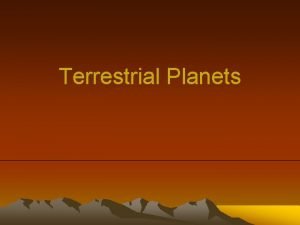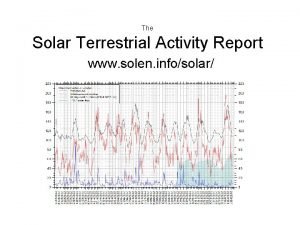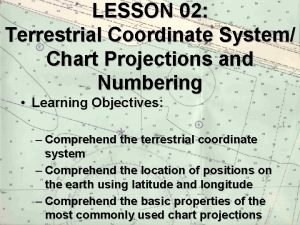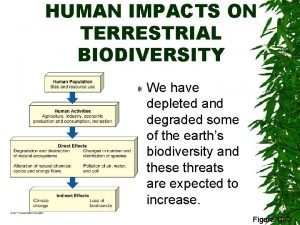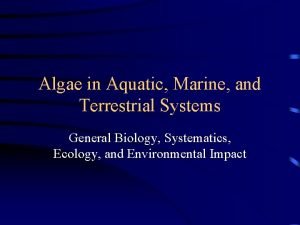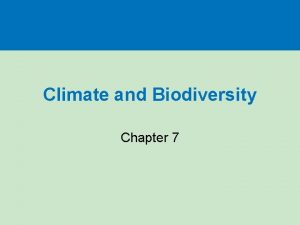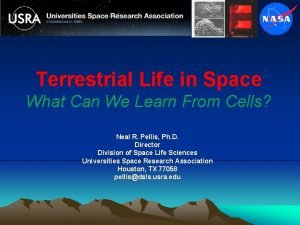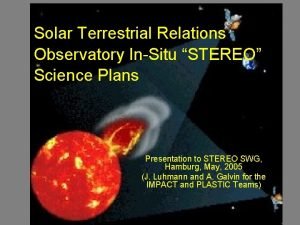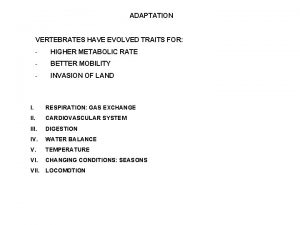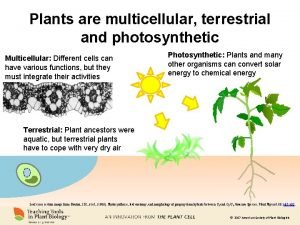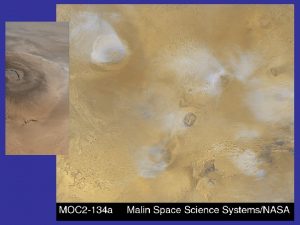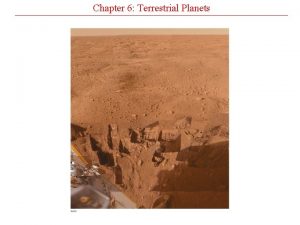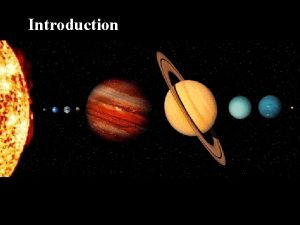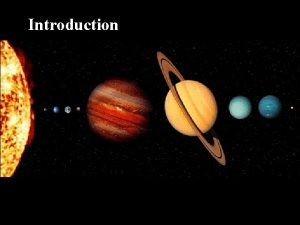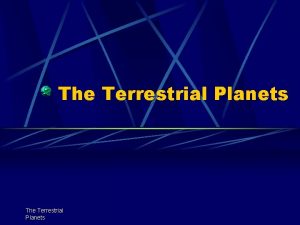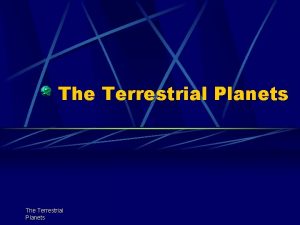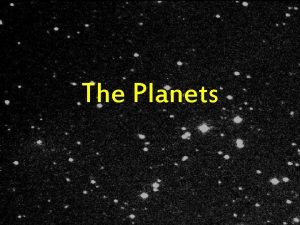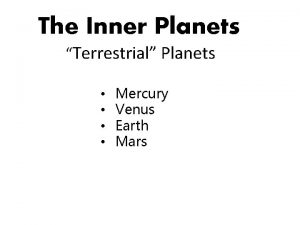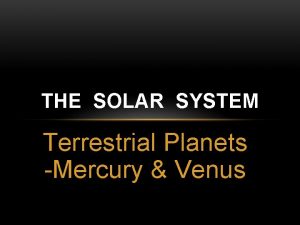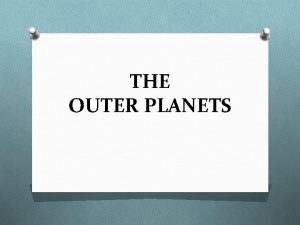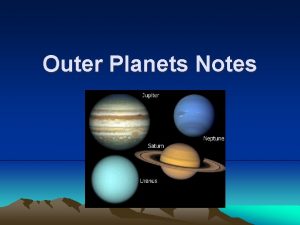Lecture 12 Atmospheres of the Terrestrial Planets Please




















































































- Slides: 84

Lecture 12: Atmospheres of the Terrestrial Planets Please remind me to take a break at 12: 45 pm! Earth’s atmosphere seen from space Claire Max May 15, 2014 Astro 18: Planets and Planetary Systems UC Santa Cruz Page 1

Topics for Today • Part 1: Introduction to Class Projects • Part 2: Lecture on Planetary Atmospheres Page 2

Why projects? • Reading, homework, lectures: “content” – What we know about our Solar System and others, and the scientific tools used to discover this knowledge • Class Projects: “enterprise of science” – The way we really do science – starting with hunches, making guesses, making many mistakes, going off on blind roads before hitting on one that seems to be going in the right direction • You will choose a general topic. Then you will formulate your own specific questions about the topic, and figure out a strategy for answering them • I will provide structure via “milestones” along the way, so you won’t get lost Page 3

Projects: Getting started • Today: – Brainstorming about potential topics – Topic selection – Group formation – First meeting of your group • Weekly e-mails to Claire from each of you: how are things going? (be sure to put “Astro 18” in subject line) • Final project outcomes: last two days of class (June 3 rd and 5 th) – Presentation in class – Written report due June 5 th Page 4

Topics chosen in the past (just a taste of what’s possible) • Life elsewhere in the universe • Hazards from Outer Space: Killer asteroids and comets • New theories of Solar System formation • Global warming on Earth: What’s the evidence? Are people causing warming? How are predictions made? • Were Mars and Venus more hospitable in the past? • Mars exploration by humans (or by robots) • Moons of Jupiter and Saturn Page 5

First task today • Brainstorm about potential project topics • How to “brainstorm”: – One person serves as scribe – Everyone suggests ideas – Scribe writes each one down – No criticisms allowed! Just put all the ideas down – Later you’ll decide which questions are most important, most interesting, etc. DON’T do that now. • Split into groups of 2 or 3 (your nearest neighbors? ) • Spend 10 minutes brainstorming about project topics – Toss around as many questions as you can, write them down – What are you curious about? Page 6

Brainstorming, continued • Main point of brainstorming is to build on each others’ ideas • Keeping the discussion positive (no criticisms allowed) encourages creativity. – Nobody should feel “turned off” or discouraged • Brainstorming a generally useful method – Used in businesses, arts, as well as science Page 7

When 10 minutes have passed, we’ll try to categorize the topics • Make groupings of related topics • Write them on board or on sign-up sheets • Ask each of you to sign up for your first choice – Include your name and email address • Form groups for each topic, get together in class to get to know each other Page 8

Example of brainstorming list for “Pluto” questions • What is Pluto made of? How do we know? How can we learn more? • How come Pluto’s orbit is so elliptical? • Did Pluto used to be an asteroid? How do we know? • Are there other Plutos? How would we find them? • Does Pluto have an atmosphere? • What will we learn from sending the New Horizons spacecraft to Pluto and Charon? Could we have learned these things from observations on the ground or in earth orbit? • Does Pluto have seasons? What are they like? Page 9

Example of brainstorming list for “planetary migration” • If we observe a solar system in which there is evidence that the planets have migrated, how can we tell what mechanism caused it? • What prevents migrating giant planets from spiraling all of the way into the star? • Can planets migrate outwards as well as inwards? • How many of the exo-solar systems that we have observed so far need to be explained by planetary migration? • Is planetary migration still happening in our own Solar System? How can we tell? Page 10

Once you’ve chosen a general topic: • What specific questions can you ask (and later answer) about your general topic? • Think about which of your questions are most interesting or important • Think about how you would address each one • Using these criteria, narrow down your list of questions to 3 – 5 • Take 10 minutes now • Hand in your list at end of class today (be sure to keep copies for yourselves!) Page 11

By next Tuesday May 20 th • Each group look into their 2 -3 questions to decide: – Does each question still make sense? – Flesh it out: use reference books (in Science and Engineering Library), websites (links on class web page) – Why is each question important? – How are they related to each other? – What resources are available to address each question – Textbooks or reference books? Articles in magazines such as Science or Scientific American or Sky and Telescope? Websites? Journal articles? – Which group members is most interested in which questions? • Each group member sign up to address 1 or 2 specific questions • Put “Astro 18” in subject line, send to max@ucolick. org before May 20 th Page 12

By Thursday May 22 nd • (Group): Together write a 2 page summary of what your project is: 1. 2. 3. 4. what are your 2 or 3 questions why are they each important (one by one) how are they related to each other what methods can you use to address them: Books? Articles in magazines such as Science or Scientific American? Websites? Journal articles? Be specific. 5. What help can I give you • Put “Astro 18” in subject line, send to max@ucolick. org Page 13

By Thursday May 22 nd, continued • From each individual (each of you): email to me – A short email giving me feedback on how your group is going: did everyone participate in your brainstorming session, did you feel included or left out, did you enjoy it? – Is someone dominating the group too much? • Are you finding the work interesting? Here’s a place to ask advice about sources, etc. • Put “Astro 18” in subject line, send to max@ucolick. org Page 14

Timetable for Projects: 2. 5 weeks • Today: brainstorm, choose general topics, form groups, refine questions • Tuesday May 20 th: read about your topic and your questions, refine them if needed, commit to specific topic • Thursday May 22 nd: each group write 2 -page summary of project plan, each individual send me email about how project is going • Week of May 26 th: dig into your topics (read textbooks, other books, articles, reputable websites); meet in person with your group to collaborate; start drafting slides • June 3 rd and 6 th: present your results in class (Power. Point or Keynote) • June 6 th: final write-up due (one paper from each group) Page 15

Planetary atmospheres: Outline • What is an atmosphere? What is its structure? • Temperature of a planet, if the atmosphere weren’t there (“no-greenhouse temperatures”) • Generic atmospheric structure • Global climate on – Earth – Venus – Mars Page 16

The Main Points • Planetary atmospheres as a balancing act: – Gravity vs. thermal motions of air molecules – Heating by Sun vs. heat radiated back into space – Weather as a way to equalize pressures at different places on a planet’s surface • Atmospheres of terrestrial planets are very different now from the way they were born – Formation: volcanoes, comets – Destruction: escape, incorporation into rocks, oceans, UV light – Huge changes over a billion years or less • Prospect of human-induced global warming on Earth is a serious issue. Can be approached scientifically. Page 17

Earth’s Atmosphere: Thin blue line • About 10 km thick • Earth’s diameter 12, 000 km, 1000 times bigger • Consists mostly of molecular nitrogen (N 2) and oxygen (O 2) • Fractions: – 78% Nitrogen – 21% Oxygen – 0. 04% CO 2 Page 18

Atmospheric Pressure Gas pressure depends on both density and temperature. Adding air molecules increases the pressure in a balloon. Heating the air also increases the pressure. Page 19

Atmospheric Pressure Page 20

Atmospheric Pressure: variation with altitude • Pressure and density decrease with altitude because the weight of overlying layers is less • Earth’s pressure at sea level is – 1. 03 kg per sq. meter – 14. 7 lbs per sq. inch – 1 bar Page 21

Effects of Atmospheres • Create pressure that determines whether liquid water can exist on surface • Absorb and scatter light • Create wind, weather, and climate • Interact with solar wind to create a magnetosphere • Can make planetary surfaces warmer through greenhouse effect Page 25

Weather and Climate • Weather is the ever-varying combination of wind, clouds, temperature, and pressure. – Local complexity of weather makes it difficult to predict. • Climate is the long-term average of weather. – Long-term stability of climate depends on global conditions and is more predictable. Page 26

Equilibrium atmospheric temperature (no atmosphere) Page 27

Equilibrium temperature: balance solar heating against cooling “No-greenhouse” temperature albedo = fraction of sunlight that is reflected by a surface Page 28

“No-greenhouse” temperatures • Conclusion: for Venus and Earth, at least, something else is going on! (not just radiation into space) Page 29

Light’s Effects on the Atmosphere • Ionization: Removal of an electron • Dissociation: Destruction of a molecule • Scattering: Change in photon’s direction • Absorption: Photon’s energy is absorbed Page 30

How do different energy photons interact with atmosphere? Page 31

How does the greenhouse effect warm a planet? Page 32

Greenhouse gases • carbon dioxide CO 2 • water vapor H 20 • methane CH 4 • others too (NO 2, . . ) • More greenhouse gases in atmosphere can lead to higher surface temperatures Page 33

Concept Question What would happen to Earth’s temperature if Earth’s surface were less reflective? a) It would go up. b) It would go down. c) It wouldn’t change Page 34

Concept Question • What would happen to Earth’s temperature if Earth’s surface were less reflective? a) It would go up. b) It would go down. c) It wouldn’t change Page 35

Melting sea ice lowers reflectivity, so Earth heats up more • This is one of the factors exacerbating global warming. • As more arctic ice melts in summer, arctic ocean absorbs more light, temperature rises Page 36

Generic atmospheric structure Page 37

Compare Earth, Venus, Mars • Earth is only planet with a stratosphere because of UVabsorbing ozone molecules (O 3). • Those same molecules protect us from Sun's UV light. Page 38

History of atmospheres on Venus, Earth, Mars • Huge changes took place over the 4. 6 billion years since planets formed! – Both Venus and Mars had more temperate atmospheres in the past than today – Venus was cooler, Mars warmer • Question: why are atmospheres of Venus, Earth, Mars so different? Page 39

Sources of atmospheric gases Outgassing from volcanoes Evaporation of surface liquid; sublimation of surface ice Impacts of particles and photons eject small amounts Page 40

Kilauea volcano outgassing Page 41

Losses of Atmospheric Gases Thermal escape of atoms Condensation onto surface Sweeping by solar wind Chemical reactions with surface Large impacts blast gas into space Page 42

Thermal Escape of atmospheric gases Page 43

Components of atmospheres on Venus, Earth, Mars • Why are they so different? • Were they always this different from each other? Page 44

The three atmospheres of Earth: “First Atmosphere” • First Atmosphere: Primordial elements – Composition - Probably H 2, He • Today these gases are relatively rare on Earth compared to other places in the universe. • Were probably lost to space early in Earth's history because – Earth's gravity is not strong enough to hold lightest gases – Earth still did not have a differentiated core (solid inner/liquid outer core) which creates Earth's magnetic field (magnetosphere = Van Allen Belt) which deflects solar wind. Magnetosphere protects any atmosphere from the solar wind. • Once the core differentiated, gases could be retained. Page 45

“Second atmosphere”: produced by volcanic outgassing • Gases similar to those from modern volcanoes (H 2 O, CO 2, SO 2, CO, S 2, Cl 2, N 2, H 2) and NH 3 (ammonia) and CH 4 (methane) • No free oxygen (O 2 not found in volcanic gases) • Ocean Formation - As Earth cooled, H 2 O produced by outgassing could exist as liquid • CO 2 could then dissolve in ocean, be sequestered in marine sediments Page 46

“Third atmosphere”: Free oxygen, lower CO 2 • Today, atmosphere is ~21% free oxygen. How did oxygen reach this level? • Oxygen Production – Photochemical dissociation - breakup of water molecules by ultraviolet light » Produced O 2 levels 1 -2% current levels » At these levels O 3 (Ozone) could form to shield Earth surface from UV – Photosynthesis: CO 2 + H 2 O + sunlight = organic compounds + O 2 - Supplied the rest of O 2 to atmosphere. • Oxygen Consumers – Chemical Weathering - through oxidation of surface materials (early consumer) – Respiration of plants and animals (much later) – Burning of Fossil Fuels (much, much later) • Once rocks at the surface were sufficiently oxidized, more oxygen could remain free in the atmosphere Page 47

Cyanobacteria and stromatolites made early oxygen for atmosphere • The first photosynthesis – Consumes CO 2, release O 2 Cyanobacteria: colonies are called stromatolites Page 48

Ozone and the Stratosphere • Ultraviolet light can break up O 2 molecules, allowing ozone (O 3) to form. • Without plants to release O 2, there would be no ozone in stratosphere to absorb ultraviolet light. Page 49

Earth's Magnetosphere • Magnetic field of Earth's atmosphere protects us from charged particles streaming from Sun (the solar wind). Page 50

Why does Earth’s climate stay relatively stable? The Carbon Dioxide Cycle 1. Atmospheric CO 2 dissolves in rainwater 2. Rain erodes minerals which flow into ocean 3. Minerals combine with carbon to make rocks on ocean floor Page 52

Why does Earth’s climate stay relatively stable? 4. Subduction carries carbonate rocks down into mantle 5. Rocks melt in mantle and outgas CO 2 back into atmosphere through volcanoes 6. Note that Plate Tectonics is essential component of this cycle Page 53

Earth’s Thermostat • Cooling allows CO 2 to build up in atmosphere • Heating causes rain to reduce CO 2 in atmosphere Page 54

Earth: hydrological cycle Page 55

Did Earth get its water from comets? • Some water from outgassing volcanoes • Second potential source of the Earth's ocean water is comet-like balls of ice. • Enter atmosphere at rate of about 20/second. • Four billion years of such bombardment would give enough water to fill the oceans to their present volume. • Possible problems: isotope ratios don’t match. Under active research. Page 56

What factors can cause long-term climate change? Page 57

Solar Brightening • Sun very gradually grows brighter with time, increasing the amount of sunlight warming planets Page 58

Changes in Axis Tilt • Greater tilt makes more extreme seasons, while smaller tilt keeps polar regions colder Page 59

Changes in Reflectivity • Higher reflectivity tends to cool a planet, while lower reflectivity leads to warming Page 60

Changes in Greenhouse Gases • Increase in greenhouse gases leads to warming, while a decrease leads to cooling Page 61

Evidence for Global Warming on Earth • Earth's average temperature has increased by 0. 5°C in past 50 years. • Most likely contributor to increased temperatures: concentration of CO 2 is rising rapidly. Page 62

Temperature increases as CO 2 concentration goes up • Most of the CO 2 increase has happened in last 50 years • Largely due to human endeavors (fossil fuels) Page 63

Intergovernmental Panel on Climate Change (IPCC) • International scientific consensus – The majority of atmospheric scientists agree – A few do not agree • Series of important reports based on scientific method (not infallible, but high quality) • Nobel Peace Prize • Look for yourselves: Good website http: //www. ipcc. ch/ Page 64

IPCC Report 2007 Glaciers and frozen ground are receding Increased Glacier retreat since the early 1990 s Area of seasonally frozen ground in NH has decreased by 7% from 1901 to 2002

The Chacaltaya Glacier and Ski Lift, Bolivia Page 66

Melting of Alaska’s Muir Glacier between 1948 and 2004 Page 67

Summer Glacial Ice Melting in Greenland, 1982 - 2007 Page 68

Global temperature will keep rising even after CO 2 emissions are reduced IPCC Report 2007 Once CO 2 gets into atmosphere, it stays there for hundreds of years! Page 69

IPCC Report 2007 Page 70

The greenhouse effect: What about Venus and Mars? Page 71

The Atmospheric History of Mars • Main questions: – What is Mars like today? – Why did Mars change? Page 72

Mars’ surface today: dry and barren Page 73

Dust Storms on Mars • Seasonal winds can drive dust storms on Mars. • Dust in the atmosphere absorbs blue light, sometimes making the sky look brownish-pink. Page 74

Mars today has polar ice caps (though different from Earth’s) • Residual ice of the south polar cap remaining during summer is primarily water ice. • Carbon dioxide ice of polar cap sublimates as summer approaches and condenses at opposite pole. Page 75

Why did Mars’ climate change? • Evidence of previous era when liquid water was plentiful • Today: Evidence for ice mixed with soil in top meter of ground Page 76

There was once liquid water on Mars • Geomorphological evidence (*lots* of it) – River and flood channels, alluvial fans, slumps, canyons, . . . • One more piece of evidence: shape of ocean basins Page 77

Climate Change on Mars • Mars has not had widespread surface water for 3 billion years • Greenhouse effect probably kept surface warmer before that • Somehow Mars lost most of its atmosphere (no more Greenhouse) Page 78

Climate Change on Mars: Role of magnetic field • Magnetic field may have helped protect early Martian atmosphere from solar wind. • Solar wind could have stripped atmosphere after field decreased because of interior cooling. Page 79

Mars’ atmosphere affected by both volcanoes and B fields? • Shortly after Mars formed, its surface temperature was ~ equal to its blackbody temperature (around -55 C). • As volcanoes dumped CO 2 and H 2 O vapor into atmosphere, greenhouse effect increased temperature above 0 C (freezing) so liquid water could exist. • Two competing effects determined amount of CO 2 in atmosphere: volcanoes adding CO 2, and rocks absorbing CO 2. Result: moderate level of CO 2. • Greenhouse effect could keep surface T > 0 C, as long as volcanoes kept erupting. • Eventually Mars' core cooled and solidified (Mars is small). Volcanic activity subsided. Magnetic field went away, solar wind particles eroded atmosphere. • Once rate of eruptions tapered off, CO 2 in the atmosphere started to fall. • As the atmosphere thinned out, the greenhouse effect weakened. Eventually the average surface temperature dropped, and surface water froze. Page 80

Atmosphere of Venus Today • Venus has a very thick carbon dioxide atmosphere with a surface pressure 90 times that of Earth. • Surface temperature very high. • Slow rotation produces little weather. Visible wavelength image of day side (red-orange); infrared image of night side (blue) Page 81

Greenhouse Effect on Venus • Thick carbon dioxide atmosphere produces an extremely strong greenhouse effect. • Earth escapes this fate because most of its carbon and water is in rocks and oceans. Page 82

Venus Climate Today: Due to runaway greenhouse effect Page 83

Venus plate tectonics? • No evidence for plate tectonics on Venus – No mid-ocean rifts – No subduction trenches • Volcanos spread evenly across surface instead of at plate boundaries, as on Earth. • Lithosphere not broken into plates; probably because heat at surface slightly softens the lithosphere. Page 84

Subduction of Earth’s crust takes carbon out of atmosphere Credit: The New Solar System, Sky Publishing Corporation • Carbonates on rock surfaces and from shells of sea life are subducted along with crust on Earth • Takes Carbon out of atmosphere, so it can’t form CO 2 • Doesn’t happen on Venus (any more …) Page 85

No carbon-silicate cycle on Venus Earth’s carbonsilicate cycle Page 86

Resurfacing on Venus • Venus has far fewer impact craters than Moon & Mercury – Dense atmosphere protects it – Volcanic resurfacing has erased most small craters • Surface age is < a billion years. – Venus was "resurfaced" by lava flows during relatively short period • This differs profoundly from Earth's crustal history. What is it telling us? – – Could Venus' present crust only have formed that recently? Could there have been a growing crust before 1 billion years ago that "turned over" as heat built up underneath, to lead to a new era of major lava flows? • Is this event correlated with the end of plate tectonics due to “bake-out” of water from surface rocks? Page 87

The Main Points • Planetary atmospheres are a balancing act: – Gravity vs. thermal motions of air molecules – Heating by Sun vs. heat radiated back into space – Weather as a way to equalize pressures at different places on Earth’s surface • Atmospheres of terrestrial planets are very different now from the way they were born – Formation: volcanoes, comets – Destruction: escape, incorporation into rocks, oceans – Huge changes over a billion years or less • Prospect of human-induced global warming on Earth needs to be taken seriously Page 88
 How are terrestrial planets different from jovian planets?
How are terrestrial planets different from jovian planets? 4 inner planets
4 inner planets Inner terrestrial planets
Inner terrestrial planets Terrestrial planet
Terrestrial planet Terrestrial planets surface
Terrestrial planets surface What are the four outer planets called
What are the four outer planets called What separates inner and outer planets
What separates inner and outer planets What separates the inner planets and outer planets
What separates the inner planets and outer planets Nobody said anything raymond carver
Nobody said anything raymond carver 01:640:244 lecture notes - lecture 15: plat, idah, farad
01:640:244 lecture notes - lecture 15: plat, idah, farad Wahis oie
Wahis oie Example of terrestrial biome
Example of terrestrial biome Gymnosperms
Gymnosperms Importance of hydroponics
Importance of hydroponics Overlapping food chain
Overlapping food chain Are bacteria autotrophs or heterotrophs
Are bacteria autotrophs or heterotrophs Chelicerata
Chelicerata Aquatic vs terrestrial
Aquatic vs terrestrial Terrestrial biomes definition
Terrestrial biomes definition A terrestrial food web
A terrestrial food web Chapter 3 section 2 terrestrial biomes
Chapter 3 section 2 terrestrial biomes Terrestrial habitat
Terrestrial habitat Terrestrial food chain
Terrestrial food chain Taiga food chain examples
Taiga food chain examples Mercury diameter km
Mercury diameter km Infosolar
Infosolar Terrestrial vs aquatic food production systems
Terrestrial vs aquatic food production systems Gnomonic chart
Gnomonic chart Impacts of wildlife trade on terrestrial biodiversity
Impacts of wildlife trade on terrestrial biodiversity Are protists terrestrial or aquatic
Are protists terrestrial or aquatic Navigation terrestrial
Navigation terrestrial Wcdma network architecture
Wcdma network architecture Human impact on terrestrial ecosystems
Human impact on terrestrial ecosystems Terrestrial soil
Terrestrial soil Terrestrial life
Terrestrial life Is venus terrestrial or gaseous
Is venus terrestrial or gaseous Solar terrestrial relations observatory
Solar terrestrial relations observatory Food web analysis activity
Food web analysis activity Terrestrial only
Terrestrial only Respiration in terrestrial animals
Respiration in terrestrial animals Biomes summary chart
Biomes summary chart Photosynthetic multicellular and terrestrial kingdom
Photosynthetic multicellular and terrestrial kingdom Glasgow thang điểm
Glasgow thang điểm Bổ thể
Bổ thể ưu thế lai là gì
ưu thế lai là gì Thẻ vin
Thẻ vin Cái miệng nó xinh thế
Cái miệng nó xinh thế Thơ thất ngôn tứ tuyệt đường luật
Thơ thất ngôn tứ tuyệt đường luật Các châu lục và đại dương trên thế giới
Các châu lục và đại dương trên thế giới Từ ngữ thể hiện lòng nhân hậu
Từ ngữ thể hiện lòng nhân hậu Diễn thế sinh thái là
Diễn thế sinh thái là Tư thế ngồi viết
Tư thế ngồi viết Thế nào là giọng cùng tên
Thế nào là giọng cùng tên 101012 bằng
101012 bằng Hát lên người ơi alleluia
Hát lên người ơi alleluia Hổ đẻ mỗi lứa mấy con
Hổ đẻ mỗi lứa mấy con đại từ thay thế
đại từ thay thế Vẽ hình chiếu vuông góc của vật thể sau
Vẽ hình chiếu vuông góc của vật thể sau Quá trình desamine hóa có thể tạo ra
Quá trình desamine hóa có thể tạo ra Công thức tính thế năng
Công thức tính thế năng Thế nào là mạng điện lắp đặt kiểu nổi
Thế nào là mạng điện lắp đặt kiểu nổi Hình ảnh bộ gõ cơ thể búng tay
Hình ảnh bộ gõ cơ thể búng tay Tỉ lệ cơ thể trẻ em
Tỉ lệ cơ thể trẻ em Lời thề hippocrates
Lời thề hippocrates Dạng đột biến một nhiễm là
Dạng đột biến một nhiễm là Vẽ hình chiếu đứng bằng cạnh của vật thể
Vẽ hình chiếu đứng bằng cạnh của vật thể độ dài liên kết
độ dài liên kết Môn thể thao bắt đầu bằng chữ đua
Môn thể thao bắt đầu bằng chữ đua Sự nuôi và dạy con của hươu
Sự nuôi và dạy con của hươu điện thế nghỉ
điện thế nghỉ Nguyên nhân của sự mỏi cơ sinh 8
Nguyên nhân của sự mỏi cơ sinh 8 Trời xanh đây là của chúng ta thể thơ
Trời xanh đây là của chúng ta thể thơ Lp html
Lp html Voi kéo gỗ như thế nào
Voi kéo gỗ như thế nào Thiếu nhi thế giới liên hoan
Thiếu nhi thế giới liên hoan Số nguyên là gì
Số nguyên là gì Fecboak
Fecboak Các châu lục và đại dương trên thế giới
Các châu lục và đại dương trên thế giới Một số thể thơ truyền thống
Một số thể thơ truyền thống Thế nào là hệ số cao nhất
Thế nào là hệ số cao nhất Sơ đồ cơ thể người
Sơ đồ cơ thể người Tư thế ngồi viết
Tư thế ngồi viết đặc điểm cơ thể của người tối cổ
đặc điểm cơ thể của người tối cổ Mật thư tọa độ 5x5
Mật thư tọa độ 5x5 Inner planets
Inner planets



